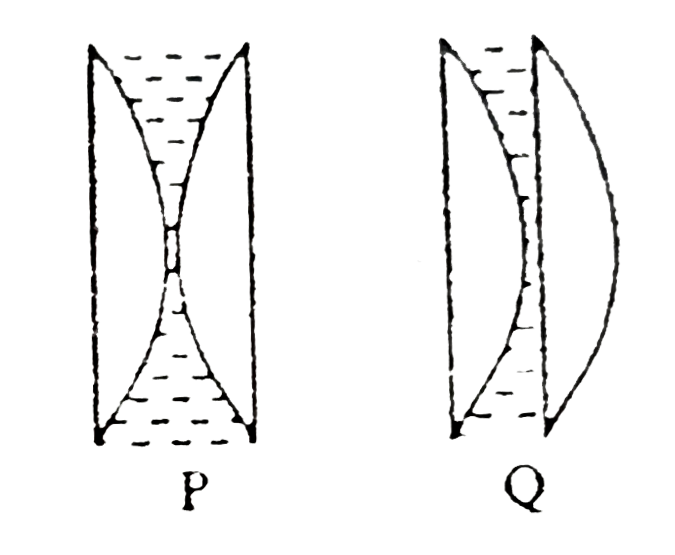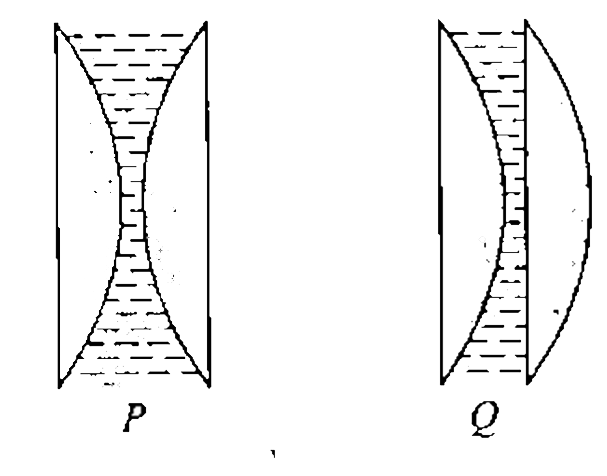A liquid of refractive index 1.33 is placed between two identical plano-convex lenses, with refractive index 1.50. Two possible arrangement P and Q are shown. The system is

divergent in P, convergent in Q
convergent in P, divergent in Q
convergent in both.
divergent in both.
1f1=(1.5−1)R+(43−1)(−1R−1R)+(1.5−1R)=1R−23R=13R
1f2=(1.5−1)R+(43−1)(−1R)+(1.5−1R)=1R−13R=23R
⇒ Convergent in both.
Topper's Solved these Questions
- BOOK - FIITJEECHAPTER - GMP ASSESMENTEXERCISE - Assertion & Reason15videos
GMP ASSESMENT
- BOOK - FIITJEECHAPTER - GMP ASSESMENTEXERCISE - Multiple Question58videos
GMP ASSESMENT
- BOOK - FIITJEECHAPTER - GMP ASSESMENTEXERCISE - Numerical Based61videos
GMP ASSESMENT
- BOOK - FIITJEECHAPTER - GENERAL PHYSICSEXERCISE - MATRIX MATCH TYPE3videos
GENERAL PHYSICS
- BOOK - FIITJEECHAPTER - GRAVITATIONEXERCISE - Numerical based Question2videos
GRAVITATION
Similar Questions
A liquid of refractive index 1.33 is placed between two identical plano-convex lenses, with refractive index 1.50. Two possible arrangement P and Q are shown in figure-. The system is:
 View Solution
View SolutionThe figure below shows a thin plano-convex lens of refractive index μ1 and a thin plano-concave lens of refractive index μ2, both having same radius of curvature R of their curved surfaces. Another thin lens of refractive index μ3 has same radius of curvature R on the two surface between the plano-convex and plano-concae lenses that the plane surfaces are parallel to each other. Find the focal length of the combination.
 View Solution
View Solution
Knowledge Check
- Question 1 - Select One
A liquid of refractive index 1.33 is placed between two identical plano-convex lenses, with refractive index 1.50. Two possible arrangement P and Q are shown in figure-. The system is:
 ADivergent in P, Convergent in QBConvergent in P, Divergent in QCConvergent in bothDDivergent in both
ADivergent in P, Convergent in QBConvergent in P, Divergent in QCConvergent in bothDDivergent in both - Question 2 - Select One
A liquid of refractive index 1.6 is introduced between two identical plano-convex lenses in two ways P and Q as shown. If the lens ma terial has refractive index 1.5, the combina tion is
 Aconvergent in bothBdivergent in bothCconvergent in Q onlyDconvergent in P only
Aconvergent in bothBdivergent in bothCconvergent in Q onlyDconvergent in P only - Question 3 - Select One
A plano-convex lens is made of refractive index of 1.6. The focal length of the lens is
A400 cmB200 cmC100 cmD50 cm
The adjacent figure shows a thin plano-convex lens of refractive index μ1 and a thin plano-concave lens of refractive index μ2, both having same radius of curvature R of their curved surfaces. The thin lens of refractive index μ3 has radius of curvature R of both its surfaces. This lens is so placed in between the plano-convex and plano-concave lenses that the plane surfaces are parallel to each other.
The focal length of the combination is
 View Solution
View SolutionA prism of refractive index 1.53 is placed in water of refractive index 1.33. If the angle of prism is 60∘, calculate the angle of minimum deviation in water.
View SolutionA glass lens of refractive index 1.5 is placed in a trough of liquid. What must be the refractive index of the liquid in order to make the lens disappear ?
View SolutionA glass lens of refractive index 1.5 is placed in a trough of liquid. What must be the refractive index of the liquid in order to mark the lens disappear ?
View SolutionTwo identical thin planoconvex lenses of refractive index n are silvered, one on the plane side and other on the convex side. The ratio of their for lengths is
View Solution

